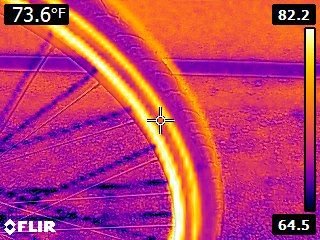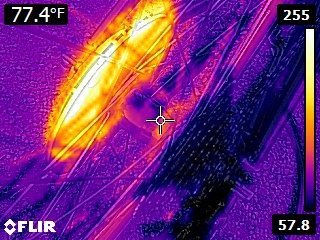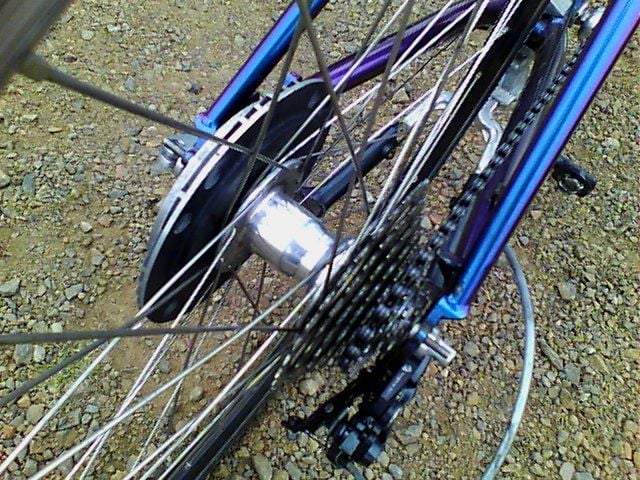Thermal images of an Aria drum brake
#1
Senior Member
Thread Starter
Join Date: May 2005
Location: SFBay
Posts: 2,334
Bikes: n, I would like n+1
Mentioned: 0 Post(s)
Tagged: 0 Thread(s)
Quoted: 127 Post(s)
Likes: 0
Liked 133 Times
in
108 Posts
Thermal images of an Aria drum brake
All these threads about brake temperatures got me curious and I decided to drag along the thermal camera on our ride today. This isn't terribly scientific, but does reinforce the "Yes, there's a lot of energy there" point. The "before" image was taken at the top of Hawk Hill just north of San Francisco. The "after" images are taken after the first portion of the descent, 0.8 miles long with 500 feet of elevation loss. The drum is on a short friction shifter and my stoker wasn't able to apply enough force to use just the drum. Not a huge surprise as the steeper section of this descent are 18% per the sign at the top of the hill. As a result, a fair amount of rim braking was used as well. No computer on this bike, but I'll put the speed between 15 and 20 mph. This is a bit slower than I usually take that descent, but my stoker was much happier about our speed than usual so it might become a regular thing. Team plus bike weight is very close to 350 lbf.
Here is the before. At first I questioned the ground being 85 °F given the 55 to 60 °F air temperature, but after placing my hands on the ground I believe it. It must still be warm from the week of warm weather and sunshine that sadly ended yesterday evening. The wind off the ocean is a fairly constant 15 mph today.

 \
\
Here we are at the bottom. We came to a stop, my stoker hopped off, and immediately took the picture. I'm guessing 15 to maybe 30 seconds after stopping. We had the camera already on, so the delay was short. While it makes sense in hindsight, I was not expecting the backing plate to be that much cooler than the drum side.


Here is one another 30 to 60 seconds later of the front rim and tire. The camera has a hard time with shiny surfaces (emissivity settings), but does ok with the tire, and the rim aside from the brake track should give reasonable results. The front brake was engaged 80% of the time on the descent, but only at a light load as the rear rim and primarily the drum were sharing braking effort. The cool air and fog likely helped, but it would be interesting to see how much heat soaks from the rim into the tire on a longer descent. Unfortunately I didn't have anyone with us on a single with rim brakes only to compare. Given the rather steep drop over the guard rail toward the ocean I'm not planning to do this on a rim brake only at this slow speed. I didn't notice until getting back that the line shows as a very different temperature than the arrow. I didn't touch both co confirm, but it's possible the retro reflective nature in the paint is messing with the camera. I'll have to try out a few retros at different angles sometime in the future.


One last picture, taken after another 30 seconds. You can see the drum has already cooled 50 °F. The hub is fairly shiny, so also doesn't get a good read. I *very* briefly touched it mid body. Contrary to what the picture says, it was definitely over 130 °F. While the drum was definitely much hotter than the hub, the hub doesn't exactly stay cold.


It would be interesting to see what a more gradual yet higher elevation change descent does. Example being the bike route out of Vail pass which averages around 4% for 2500 ft. Our team weight was also without any panniers, so it wouldn't be difficult to put quite a bit more weight on the bike. Unfortunately I don't have any plans to end up in that area soon.
Here is the before. At first I questioned the ground being 85 °F given the 55 to 60 °F air temperature, but after placing my hands on the ground I believe it. It must still be warm from the week of warm weather and sunshine that sadly ended yesterday evening. The wind off the ocean is a fairly constant 15 mph today.

 \
\Here we are at the bottom. We came to a stop, my stoker hopped off, and immediately took the picture. I'm guessing 15 to maybe 30 seconds after stopping. We had the camera already on, so the delay was short. While it makes sense in hindsight, I was not expecting the backing plate to be that much cooler than the drum side.


Here is one another 30 to 60 seconds later of the front rim and tire. The camera has a hard time with shiny surfaces (emissivity settings), but does ok with the tire, and the rim aside from the brake track should give reasonable results. The front brake was engaged 80% of the time on the descent, but only at a light load as the rear rim and primarily the drum were sharing braking effort. The cool air and fog likely helped, but it would be interesting to see how much heat soaks from the rim into the tire on a longer descent. Unfortunately I didn't have anyone with us on a single with rim brakes only to compare. Given the rather steep drop over the guard rail toward the ocean I'm not planning to do this on a rim brake only at this slow speed. I didn't notice until getting back that the line shows as a very different temperature than the arrow. I didn't touch both co confirm, but it's possible the retro reflective nature in the paint is messing with the camera. I'll have to try out a few retros at different angles sometime in the future.


One last picture, taken after another 30 seconds. You can see the drum has already cooled 50 °F. The hub is fairly shiny, so also doesn't get a good read. I *very* briefly touched it mid body. Contrary to what the picture says, it was definitely over 130 °F. While the drum was definitely much hotter than the hub, the hub doesn't exactly stay cold.


It would be interesting to see what a more gradual yet higher elevation change descent does. Example being the bike route out of Vail pass which averages around 4% for 2500 ft. Our team weight was also without any panniers, so it wouldn't be difficult to put quite a bit more weight on the bike. Unfortunately I don't have any plans to end up in that area soon.
Likes For jccaclimber:
#2
Full Member
Great post, very interesting and informative.
#3
Full Member
Very interesting, thanks for posting. I know that the emissivity of the surface you are measuring has a big impact on accuracy, however, as you said, for these analysis, this is close enough.
It would be interesting to see similar for disc brakes and to see (relatively) how much hotter the rotors achieve. I have a tandem with an Arai drum and rim brakes, and another with disc's, but alas, I am FLIR-less.
It would be interesting to see similar for disc brakes and to see (relatively) how much hotter the rotors achieve. I have a tandem with an Arai drum and rim brakes, and another with disc's, but alas, I am FLIR-less.
#4
Senior Member
Thread Starter
Join Date: May 2005
Location: SFBay
Posts: 2,334
Bikes: n, I would like n+1
Mentioned: 0 Post(s)
Tagged: 0 Thread(s)
Quoted: 127 Post(s)
Likes: 0
Liked 133 Times
in
108 Posts
Very interesting, thanks for posting. I know that the emissivity of the surface you are measuring has a big impact on accuracy, however, as you said, for these analysis, this is close enough.
It would be interesting to see similar for disc brakes and to see (relatively) how much hotter the rotors achieve. I have a tandem with an Arai drum and rim brakes, and another with disc's, but alas, I am FLIR-less.
It would be interesting to see similar for disc brakes and to see (relatively) how much hotter the rotors achieve. I have a tandem with an Arai drum and rim brakes, and another with disc's, but alas, I am FLIR-less.
Knowing that and the energy (mgh) from the hill would also give some idea of how much energy was already radiated or dissipated elsewhere on the descent.




